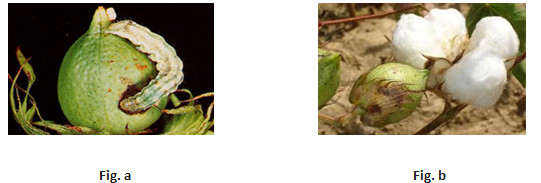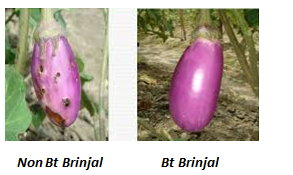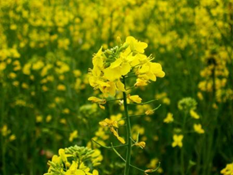Author: Omkar Maharudra Limbalkar
The history of Agriculture in India begun from Indus Valley Civilization Era and even before that in some Southern parts of India. Today, India ranks
second position globally in total farm production. Agriculture and allied account for 13.7% of the GDP (gross domestic product). The contribution of agriculture to India's GDP is day-by-day declining with the country's broad-based economic growth. Indian agriculture facing problem i.e. availability of improved varieties with assured yield with less inputs and assured supply of improved varietal seed even in remote areas, there are many more constraints but if India work on these two constraints definitely there will be drastic changes in agriculture production. Developing new varieties is not as simple task as we think because it take 10-12 years of breeder to end up with good variety by traditional way of breeding but there are some biotechnological techniques available and when associated with traditional breeding, definitely we would have assured and good output within short period. Hence to mitigate the increasing food demand, Indian agriculture couldn’t be rely only on conventional way of breeding and have to accept modern techniques in agriculture.
- Transgenic cotton: as boon for cotton industry
The main selling points of Bt cotton are the reductions in pesticides use and reduces the ecological damage. If we go into scientific basis of Bt cotton and its way to control pest, it is role of just single gene that has been transfer from bacterium Bacillus thuringiensis i.e.cry1ac (Bollgard I), cry2ab (Bollgard II), or vip3A (Bollgard III), into cotton. Insects belonged to Lepidoptera are sensitive to crystalline endotoxic protein (important protein for insect digestive system) produced by Bt gene which in turn protects cotton from bollworms. The beauty of these gene is they are very specific to certain group of insects hence it is additional advantage to ecological balance. Increase harvests and farm income by reducing crop losses due to pest attacks. As because of natural selection occur in insect, there is development of resistance in lepidopteran against Bt gene in cotton. Hence Monsanto has advances gene construct to combat the problem of insect resistance. But most of NGO’s has raised this issue and opposing the GMO’s but in true sense developing resistance against any gene is natural process and it is occur in every case even in resistant varieties developed by conventional approaches too. India has developed Bt-cotton varieties such as Bikaneri Nerma and hybrids like NHH-44, we should promote the indigenous research also.

Non Bt-cotton boll with bollworm attack / Healthy Bt-cotton boll free from bollworm attack
- Bt BRINJAL: The incomplete story

Non Bt Brinjal / Bt Brinjal
Even though GEAC (Genetic Engineering Approval Committee) had approved the release of Bt-brinjal in India but because of oppose from NGO’s and civil society group raised the issue related to health and biosafety. A major contributor to this growing concern was the fact that GEAC has not at all conformed to the rigorous standards involved in scientific approval of such unique food technologies. So serious are the concerns, that the issue of releasing GM food was a subject of Supreme Court hearing. Besides leading scientists have expressing serious support for its release and many Legislators have opposing the release. As a result, the Indian Environment and Forests Minister Mr. Jairam Ramesh had been forced to refuse the approval for commercial release of Bt brinjal based on the GEAC clearance of 14th October 2009. But in October 30, 2013 Bangladesh Agricultural Research Institute (BARI) received permission from the ministries of Environment and Forests (MoEF) and Agriculture (MoA), to release four varieties of Bt brinjal for the 2013–2014 growing season.
GM MUSTARD: The recent controversy
Still most of people think that the transgenic techniques can only use for developing crop resistant to insect pest like cotton or maize and not else but in fact it has wide range of uses. The practical example of this is the GM Mustard variety DMH-11 is developed by Deepak Pental, Professor of Genetics at the University of Delhi and a former vice-chancellor for making mustard amenable for hybridization. It is very important to develop hybrid in crop to get maximum yield per acreage but the mustard is self-pollinated crop and it became very cumbersome and costly to do crossing manually. DMH-1 (Dhara Mustard Hybrid-1), the only hybrid released by the Indian Council of Agricultural Research (ICAR) after extensive field trials. That involves a different technique, called cytoplasmic male sterility (CMS) it’s effective but large-scale seed production isn’t possible and also has problems with stability and cannot be used in many mustard lines.
If we need hybrid seeds with high purity and large quantity, for that a robust pollination control mechanism is needed. So in DMH-11 (Dhara Mustard Hybrid-11) the pollination control mechanism has been used is transgenic male sterility i.e. barnase and barstar system. These genes have been isolated from bacterium Bacillus amyloliquefaciens . As because barnase gene in female parent make plant male sterile and barstar in male parent makes it male fertile. The barnase gene is linked with other gene from bacterium “bar “responsible for herbicide tolerant. The herbicide tolerance in DMH-11 is incorporated only for killing the fertile plants in hybridization plot, so that the pollen from these male fertile individuals of same variety can be avoided. On spraying herbicide (a gene specific herbicide Bastar), only female lines containing barnase gene will survive and there is ease in hybridization with suitable heterotic male plants.

Fig. BB system changing makes easy hybridization
Indian mustard is a winter crop of 135-days life cycle and grown in a completely different ecology. European rapeseed is having good source of variability for yield and quality traits. But if we you grow European rapeseed here, we will get nothing. Rapeseed has a very narrow genetic base but, with the use of variability available in Rapeseed germplasm we can have better yield with heterosis breeding. The heterosis in any crop has been exploited by hybridization between two diverse parents, DMH-11 uses, East-European line called EH2 as male parent and Varuna as the female, but DMH-11 uses transgenic technology. The fundamental insight is that we will get heterosis (or high-yielding hybrids) only if we cross an East European line with an Indian pure (cultivar) line. Indian-Indian crossings won’t have that effect irrespective of what technology we use. DMH-11 generally yields 20%-30% more than its parents. Hybrids are more productive than their pure-line parents. That’s what really matters and that’s all that we claim. Barnase- barstar system is stable and CMS-based systems are a scientific dead-end.
Controversies and the fact with GM mustard:
- Low amount of heterosis in self-pollinated crops so why India want mustard hybrid , Even though it is self-pollinated crop but still these crops having some level heterozygous balance for exploiting heterosis and by crossing with diverse parental lines.
- Yields of the European lines higher than our Indian mustard varieties so why India need GM mustard. But by crossing European and Indian lines we will have 20-30% yield more than both the parents.
- Promotion to herbicide industries. Actually this BB technique is solely related to ease of doing hybridization and not making crop resistant to herbicide.
- Once GM mustard is cleared it will open the way for other GM seeds that are protected by patents of multinational seed companies. This is very bad attitude that one have. During green revolution there were one argument that we have opened doors to international fertilizer companies but afterward we have developed our own fertilizer manufacturing plants and we have many agriculture research center and agriculture universities then what will be work of them
- The Indian farmer will be beholden to multi-national companies . But we keep our farmers stuck to poor-yielding varieties and importing oil for them. Either way, our money is going to go and the dream of doubling the farmer income is remain dream only.
Conclusion :
As far as the organic farming is concern we can expect quality but quantity can’t, hence to feed the growing population in any developing nation there must be follow up of modern biotechnological technique in agriculture for ensuring the yield. The social activist and few NGO’s have questioned regarding the biosafety issues but experts from different authority have been checked the hazardous effect on human, animal and environment. Hence being science scholar we should appreciate the scientist’s efforts in these areas and should accept the truth rather supporting baseless controversy.
About Author / Additional Info:
M.Sc. research scholar in Division of Genetics at Indian Agriculture Research Institute (IARI), New Delhi